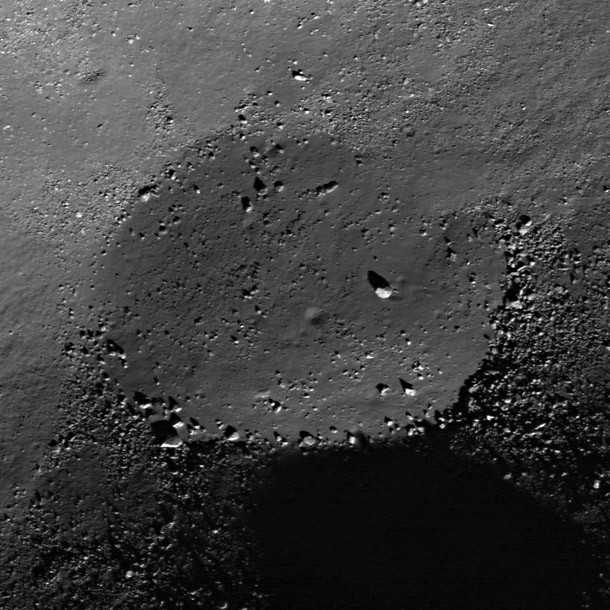A lunar crater illusion you’ll flip for
The Lunar Reconnaissance Orbiter has a great blog where they post images from the hi-res camera onboard. I was perusing a recent image, and was a bit befuddled:
What the heck? Is this a plateau of some kind? Is that a small dome just below the center of it? The whole thing looks pitted around the edge, too, like some sort of erosion has taken place. But that can’t be right!
Happily, being an old hand with optical illusions, I knew exactly what to do. I flipped the image over, and all became clear:
Ah, that’s better. Now you can see what’s what: it’s a crater with boulders in it. The small dome is now clearly a tiny meteorite impact crater. What looked like pitting is now obviously rocks and rubble that have slid down the slope of the crater wall.
This is an old illusion. Having evolved on the surface of a planet, we interpret our surroundings assuming sunlight is coming from above. If we see a picture rotated such that the sunlight is coming from below, it plays tricks on our perception. Shadows point the wrong way, making craters look like domes. Flip the picture over, and voila! All is as it should be.
This image is a wonderful example of this illusion (though I’ve never run across a name for it. I suggest “Plait’s Plateau”). You can take lots of lunar pictures and see it if you rotate them. I suggest you check out the LRO archive, because it’s a terrific lesson that what you see is not always what you get (and also because the images are simply too cool). It’s incredibly easy to fool our brains, and if more people realized that then it would be a lot easier for them to be skeptical of what they see, and of claims from other people about what they see!
Related posts:
Terra spots an impact on, um, Terra
Spelunking the lunar landscape
Originally posted on The Bad Astronomy Blog.



It looks like a recession in the middle of a larger crater.
In BOTH pictures.
But I don’t have a broader image with which to compare.
Agree about lighting, and angle and stuff like that. I’m just saying, that is what I saw in both pictures.
“Having evolved on the surface of a planet, we interpret our surroundings assuming sunlight is coming from above.”
I bet it’s nurture rather than nature. Had you been raised in an environment where the light comes from below, your interpretation of the photo would’ve been different.
Perception isn’t something you learn. That’s why you can’t remediate perceptual problems, you just have to find a way to get around the problem. (Education major.)
The ability to infer shape from shading is probably innate, but I think we do learn that light comes from above.
Perception definitely has a learned aspect. Although I suspect the directionality of sunlight is something relatively hardwired (as is basic facial configuration) it takes a loong time for the brain to organise the chaos of visual input into something which makes sense. Depriving animals of visual stimuli in the first months of life – or even the ability to meaningfully interact with their environment – leads to them being unable to perceive or act in the world correctly (http://bit.ly/d215ex has a very quick run down).
Perceptual systems ‘expect’ certain kinds of input and very young infants will be surprised when these expectations aren’t met (loads of cool research in this area around number and physics), but that doesn’t mean the systems aren’t amenable to environmental modulation. It’s a bit like our circadian rhythm – it makes sense for the set point to be around 24 hours, but it would be dumb if the system didn’t take account of other variables like ambient sunlight.
ah one can find a great example of this illusion on youtube. to save myself the trouble that comes with links, i’ll jus say to search “magnet like slopes” on youtube and it should be the first to pop up.
Not seeing the plateau, it looks like a crater from both angles.
You know it’s funny,when I 1st read the article I did see the top image as a plateau, and the flipped image as a crater.But looking at it now, I also see both images as a crater.Weird.
I see a plateau from both angles.
I was looking for the monolith!
Nice work.
One to file in memory for claims of personal incredulity.
Cheers, Phil.